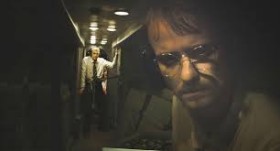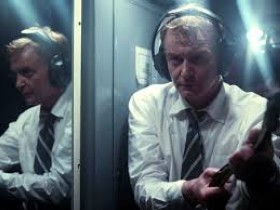Fotoet viser et privat russisk transportfly, besætningen er i cockpittet, men jeg er i filmen i lastrummet hos mændene og lasten af våben og ammunition. Mændene er ret forskellige, det ser jeg allerede på de andre stills. Han som sidder ned udmattet i dybe tanker er danskeren Niels Holck, han som står op og allerede – om lidt vil lastporten agter blive åbnet og flyet stige i en stejl vinkel – har spændt selerne, han som lige før personligt ved et greb i en af transportkasserne har bevæbnet sig med pistol og patroner, forberedt sig på sin måde, han er englænderen Peter Bleach. Det er de to, det handler om, det her.


SYNOPSIS
Og denne nat i december 1995 nedkaster de så 4 tons våben i faldskærme over et sted i Indien. Få dage senere vender Holck hjem til Danmark med den dybe hemmelighed. Først da Bleach bliver anholdt af inderne som engelsk civil MI5 agent og står til dødsstraf for våbensmuglingen, dukker Holcks navn under den omfattende internationale efterforskning i sagen også op i offentligheden.
Ved hjælp af dybt disciplineret udførte rekonstruktioner i forholdsvis korte scener med spillefilmkarakter kombineret med dokumentariske optagelser gennem tre år og et stort arkivstof fortæller filmen og disse to mænd parallelt i hver sin fremstilling en aldeles medrivende flerdobbbelt agenthistorie om to mænd, der på en fælles mission sætter livet på spil, naturligvis med hver deres skjulte agenda, som begge oven i købet ændres undervejs.
Missionen mislykkes, men det øger blot filmens spænding, og på det tidspunkt er jeg kun en tredjedel inde i fortællingen. Det mærker jeg tydeligt, for jeg er inde i en sikkert administreret fortælling. En mørklægning ved mørke magter finder sted omkring de to mænd. Mellem dem og bag deres rygge. Deres egen efterforskning af de skjulte manøvrer samt det næsten 20 år lange politiske og journalistiske efterspil, som filmen herefter skildrer, faktisk er konstrueret af og selv er en del af, ja det drama fortsætter og fortsætter for eksempel med begivenhederne disse dage omkring lanceringen af filmen og nu ved salget af en times version til indisk tv, som er meddelt i dag. Det er alt sammen som forlænget filmfortælling, som nye scener efter credits er rullet færdig. Filmværket arbejder fortsat med virkelighedsbegrebet, og de to mænd leder endnu, efter filmpremieren, om ikke efter sandheden, den er måske gået op for dem, men så efter flere skjulte beviser og vidner.
TO GRUNDINTERVIEWS
Andreas Koefoed skriver i pressematerialet om sin motivation og baggrund for at lave filmen. Og det er, nu jeg har forladt filmens historie efter gennemsynene, på sin måde lige så interessant, for her ligger måske en forklaring på, hvorfor det er så vældig god en en film, og i det ligger formodentlig en kommentar til den kunstneriske kerne, som enhver tilskuer nu i dagevis må vende og dreje i tankerne: hvad handler filmen egentlig om? Det begyndte for tre år siden, skriver Koefoed, da han mødte Niels Holck første gang, ”han stod med ryggen mod muren og frygtede at blive udleveret til Indien. Han fortalte mig sin historie. Og han gav mig lov til at filme ham.” Når jeg nu ser Koefoeds færdige film, ser det optagelsesmateriale for mig ud til i princippet at være til stede i filmen som ét langt grundinterview klippet til én lang kronologisk (tror jeg) fortælling. Adam Nielsen skal have tak for den vældige ro, der med det greb skabes i filmens forløb, som ellers, må jeg sige, er fyldt med urolighed.
Det er imidlertid den anden mand, Peter Bleach, som i sin suveræne tilstedeværelse i billedet skaber begyndelsen til og det følelsesmæssige grundlag for den ro. Ham mødte Koefoed nogle måneder senere, ” den engelske våbenhandler, der forgæves forsøgte at få Holck arresteret i 1995, men blev ofret af sit eget land og efterladt i et indisk fængsel i Calcutta. Det blev klart, at der lå en fantastisk og foruroligende historie lige foran næsen på mig.” Og i filmen bliver det til det andet grundinterview, som Adam Nielsen med sikker hånd anbringer parallelt med det første, så jeg næsten samtidig hører og oplever to beretninger om det samme, men så forskellige i de nogle steder bittesmå detaljer, som klipningen lader stå uden at pointere, at de forbliver levende autentiske erindringsbrikker til det uoverskuelige puslespil, jeg sidder med foran mig. ”To mænd på en vanvittig mission i et fly med 4 tons våben, to skæbner der vikles ind i hinanden for altid. En kompromisløs idealist og en kølig våbenhandler/dobbeltagent. Med hver deres agenda. Dobbeltspil, brændende idealisme, stikkeri, svigt, tilgivelse og forsoning.” Det er store ord, Koefoed her har fat i, og jeg vender og drejer hvert enkelt, tøver længe ved Holcks ”brændende idealisme”, vil vende tilbage til den tøven, men anerkender, at filmen generelt dækker store ord ind, der er i den grad værktyngde til det.
FORM
Andreas Koefoed skriver: ”Jeg lagde hovedet i blød og udfordrede mig selv maksimalt for at finde frem til, hvordan jeg kunne fortælle historien bedst muligt. Der var potentiale til en real-life spændingsfilm med eksistentielle dimensioner og jeg kom frem til at løsningen måtte være at forene det bedste fra dokumentarfilmen med det bedste fra fiktionen og stole på, at det ville spille sammen. ” Jeg går ud fra, at det med at fortælle historien bedst muligt, går på det underholdningsmæssige håndværk, mens formuleringen ”eksistentielle dimensioner” svagt berører en vilje til at bestemme en kerne, som ikke alene er den komplicerede historie og dens opklaring. Jeg fornemmer, det har med de to mænd, de to karakterer at gøre, deres shakespeareske potentiale rent ud skrevet. Og det nødvendige greb ligger i tidens æstetikdiskussion, nu måtte det gennemføres, det nødvendige, at forene dokumentar og fiktion. Koefoed skriver: ”De virkelige, multifacetterede karakterer, de naturlige autentiske scener, følelserne, særhederne og tyngden, der ligger i det ægte og dokumentariske kombineret med den dramatik, action, struktur og klarhed, som fiktionen giver mulighed for.”
Det er modigt og værdifuldt, at en filminstruktør offentliggør ikke blot sine skitser fra notesbogen, men sine endelige afgørelser i målsætningsform. Og så er jeg ligeglad med, om det er sket retrospektivt ,eller det faktisk er et originalt dokument fra en tidlig manuskriptfase. Nu ved jeg temmelig meget om, hvad den kunstneriske ambition var. Det skulle være en æstetisk forsøgsopstilling, og det havde således på en måde også været interessant, hvis antagelserne var blevet falsificeret. Men som i videnskaben er og bliver det dejligst, hvis de bekæftes. Det er trods alt den situation vi kalder: eksperimentet lykkedes! Sammenføjningen af rekonstruktion og dokumentar i Andreas Koefoeds film er lydefri i hver eneste lodning, svejsning, syning…
”Jeg satte mig for at rekonstruere våbennedkastningen med dramatiske scener med dialog, hvor man er til stede i et ’nu og her’ med karaktererne og ikke blot bruge rekonstruktionen som illustration af nogle hændelser med interview ind over…” Koefoed isolerer rekonstruktionerne som den vanskelige ting, som udfordringen. Jeg tror han mener, at lykkes de, vil de uden videre kunne monteres med de dokumentariske optagelser. Sådan er det bestemt gået her i hans film, og jeg tror, det skyldes den særlige omhu, hvormed, han har sammensat sit hold. Han allierede sig med ”de dygtigste folk, jeg kender, fotografen Manuel Claro, klipperen Adam Nielsen, manusforfatteren/instruktøren Tobias Lindholm, James Marsh (”Man on Wire”) som konsulent. Uden dem var filmen aldrig kommet i mål.” Nej, sikkert ikke. Lad mig pege Marsh lidt mere ud, slægtskabet med konstruktionen i hans film om manden som gik på line mellem tvillingtårnene i New York er tydeligt i enhver detalje, jeg vælger at gennemtænke. Det er meget smukt. Og lad mig også erindre om Adam Nielsens cinematografi i film som ”Den sidste dans”, ”Ghosts of Cité Soleil” og ”Vesterbro”. Konsekvent er her karakterernes udvikling i fuldstændig balance fra sekund til sekund, der er i alle filmene den lysende klarhed fra først til sidst, og så er der udnyttelsen af den mindste materialestump blot den rummer et strejf af den autenticitet, som er afgørende for værkets helhed som noget, jeg tror på og bevæges af.
Danmark, 2014, 90 min.
DOXBIO viser VÅBENSMUGLINGEN i en række biografer i morgen, onsdag 4. juni, de fleste steder kl. 19 se hvilke og bestil billet her: http://www.doxbio.dk/?page_id=23
http://www.dfi.dk/faktaomfilm/film/da/87821.aspx?id=87821




